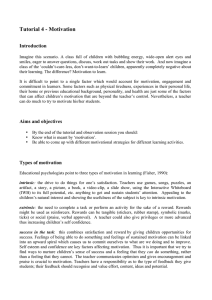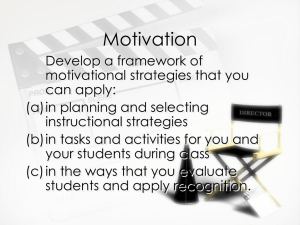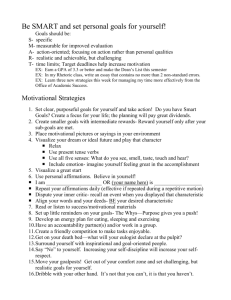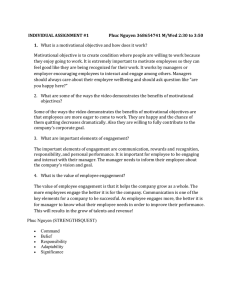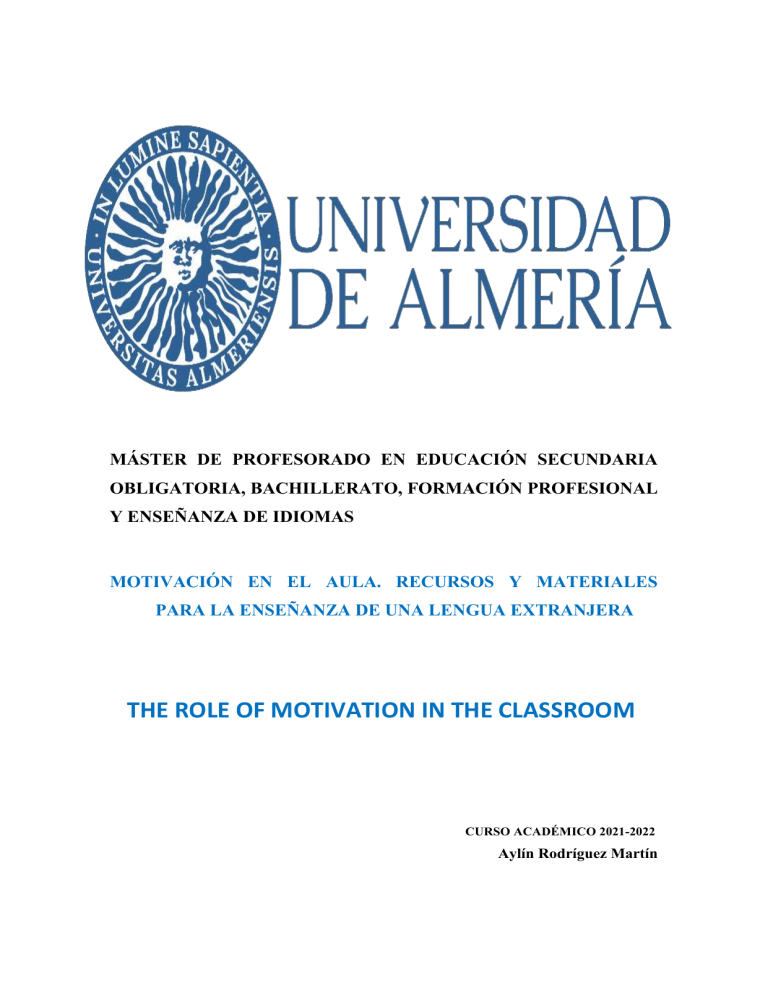
MÁSTER DE PROFESORADO EN EDUCACIÓN SECUNDARIA OBLIGATORIA, BACHILLERATO, FORMACIÓN PROFESIONAL Y ENSEÑANZA DE IDIOMAS MOTIVACIÓN EN EL AULA. RECURSOS Y MATERIALES PARA LA ENSEÑANZA DE UNA LENGUA EXTRANJERA THE ROLE OF MOTIVATION IN THE CLASSROOM CURSO ACADÉMICO 2021-2022 Aylín Rodríguez Martín Content 1. Defining motivation............................................................................................ 3 1.1. What is motivation? ..................................................................................... 3 1.2. Main theories ................................................................................................ 3 2. Motivation and engagement in the classroom .................................................... 4 2.1. Being a motivational teacher........................................................................ 4 2.1.1. Motivational perspective of tasks .......................................................... 4 2.1.2. Strategies to increase student interest in academic tasks....................... 4 2.1.3. Implementation of rewards in the classroom......................................... 5 2.2. Building a motivational environment .......................................................... 6 2.2.2. Enhancing students’ autonomy .............................................................. 6 2.2.3. Assessment and student motivation ....................................................... 6 2.3. Motivational problems ................................................................................. 6 3. Keeping Students Engaged: A review ................................................................ 7 4. Does Cooperative Learning Increase Students’ Motivation in Learning? A review ..................................................................................................................... 8 5. Conclusion .......................................................................................................... 9 6. Bibliography ..................................................................................................... 10 1. Defining motivation 1.1. What is motivation? Before going deeper into the importance of motivation in the classroom, it is necessary to define the concept. Motivation refers to the behavioural intensity and emotional quality of a person’s active involvement during a task (Connell, 1990; Connell & Wellborn, 1991; Fiedler, 1975; Koenigs, Fiedler, & deCharms, 1977; Wellborn, 1991). In other words, motivation refers to the enthusiasm and willingness a student shows when carrying out a task. We can divide the concept of motivation into intrinsic and extrinsic motivation. The intrinsic motivation refers to the fact of performing a task because it is rewarding to the person, just for the sake of learning or improving. On the other hand, extrinsic motivation means carrying out a task or exhibiting a behaviour because of external stimuli, such as receiving a reward or avoiding punishment. 1.2. Main theories In order to understand how motivation works and how it should be addressed in the classroom, it is necessary to contextualise it under some of the existing theories. 1. Self-determination theory: it is one of the main current theories related to intrinsic and extrinsic motivation. Ryan and Deci (2009) proposed that individuals have to meet three basic needs to be motivated and engaged in activities: autonomy (to feel self-directed), competence (to be able to perform a set of tasks) and relatedness (to feel part of a social network). 2. Attribution theory: Weiner (1986) defined how people reacted to certain occurrences such as success or failure and how these two factors were directly related to motivation. If a student fails an exam, he can follow two paths. He might attribute failing to the lack of study and develop a more positive emotion to push him to study harder next time, or in contract, he might attribute it to not being good at that particular subject, and therefore develop a negative feeling which can trigger the motivation towards that given subject. 3. Expectancy-value theory: in this theory, academic motivation relies both on the students’ beliefs about their abilities to succeed with tasks, expectancy, and how they value those tasks. In order to have students engaged in a task, they need to see the importance, the usefulness and the worthiness of it. 4. Social cognitive theory: Bandura (1989) introduced two important concepts when studying academic motivation. First, he demonstrated that students could engage in behaviours seen in others. He also introduced the concept of self-efficacy, where students develop feelings and beliefs of ability to perform a particular task. In this sense, teachers have the potential to influence students into strengthening their self-beliefs and self-esteem. 5. Goal orientation theory: this theory focuses on students’ reasons for engaging in academic tasks. Here we can differ from two terms: mastery goals and performance goals. When student develop a mastery goal, they focus on the task itself, the content learned and the effort employed rather than the unique outcome. On the other hand, students who engage in performance goals, only focus on how they are being evaluated by others based on a final grade or result. The way we instruct, evaluate or arrange the classroom play a huge role on students adopting a certain type of goal, which will directly affect the motivational levels. 2. Motivation and engagement in the classroom 2.1. Being a motivational teacher 2.1.1. Motivational perspective of tasks As educators, when it comes to motivation management, we have the responsibility to keep students engaged and to take into account a number of factors, such as the tasks involved, the way to evaluate them or the rewards used. As for tasks assignment, it is important to make tasks both engaging and useful for the students. Tasks involving authentic, real world related content are more likely to raise the students’ attention and keep them motivated at all times. As mentioned before, one the most influential theories regarding task assignment, is the expectancy-value, where the value of the task is the prime mover. When learners find activities engaging, because of either the attractive content or methodology applied or useful for their daily lives, they are more likely to focus and develop a positive attitude to the subject. 2.1.2. Strategies to increase student interest in academic tasks Being aware of students’ personal interest can provide opportunities to foster motivation and involvement in the classroom. Inevitably, it is impossible to fulfil every student’s interest and at some point, all of them will have to face tasks that might not align with their personal likings. What is important here is that teachers have to try their best to offer a more personal teaching approach that involves everyone in the classroom. Some of the most important strategies to implement when assigning academic tasks are the following: 1. Use activities related to content that students know about and can easily relate to their prior knowledge. 2. Encourage students to be active learners. Boost their critical thinking and reasoning with activities when they can debate and bring up their own contributions. 3. Guide students throughout the task. Assist students to focus on the most important aspects of the task, so they do not lose interest when things get harder. 2.1.3. Implementation of rewards in the classroom The use of rewards must be used carefully in the classroom, since some of them can turn out to be either effective or have detrimental effects on students’ motivation. When planned and employed accordingly, they can mean a great boost for learners’ engaging levels. Below, some of the most important considerations can be found: 1. Reward students for effort and improvement. Traditionally, rewards have always been used to gift the “elite” of the classroom. Teachers should develop a new mind-set, where effort and improvement are appreciated and praised. 2. Rewards and control should not be connected. Students, who might perceive that a reward is related to a particular behaviour, can develop a negative attitude reducing their intrinsic motivation. 3. Keep rewards private. Sometimes the use of rewards in front of their peers in the classroom might make some students uncomfortable or embarrassed. The best practice is to inform the student in private to avoid making students selfconscious. 2.2. Building a motivational environment 2.2.2. Enhancing students’ autonomy Students who feel in control of their own learning process tend to develop a more positive attitude towards learning. In this sense, teachers also play a huge role in motivating their students. Teachers can adopt either a more controlling strategy or autonomy-supportive strategy, the last being rarer to find. As Deci & Ryan (1985) stated, one person influences the motivation, learning and performance of other, so, in the school setting, teachers following a more autonomy-supportive approach show their students the value of mastery and intrinsic motivation as well as greater conceptual understanding. Giving students a place in the classroom, where they feel free to develop their own knowledge and carry out activities by themselves, creates a more fulfilling and productive environment, and consequently enhances higher level of engagement. 2.2.3. Assessment and student motivation Stiggins define assessment in the classroom as “the process of gathering evidence of student learning to inform instructional decisions” (2005, p. 5). Nowadays, students still are assessed only based on their performance in the classroom, that is to say, by grading them on their final academic results. This procedure not only seems unfair, but also triggers students’ motivation, since just a small part of the process in valued. It is necessary to leave behind the traditional ways of evaluating and come up with solutions to assess students’ effort and improvement in the classroom without relying only on the result. Promoting mastery-goal activities and assessment will enhance the learners’ engagement, as their day-to-day effort and work put into the classroom would be appreaciated. At the same time, we have to make students responsible of their own learning, and therefore their own assessment, by encouraging students to care and value their personal achievements. 2.3. Motivational problems When the classroom atmosphere is not optimal, a variety of motivational problems might arise. In the following section, we are going to analyse and review some of the possible motivational problems that can occur in the classroom. 1. Motivation and Behaviour Management: when students are motivated and focused, they do not engage in off-task activities, so providing appealing activities will reduce the possibilities of student’s misbehaviour. 2. Motivation and Anxiety: It is crucial to be aware of a student’s attitude towards something that is causing him/her some anxiety. As educators, we have to be very cautious about the practices, instructions or strategies we use because sometimes they might be detrimental. 3. Motivation and Learned Helplessness: Students might experience learned helplessness when they cannot relate their behaviour or work to their outcomes. In these cases, teachers can help by finding out the root cause of the problem that in some cases in just a matter of a poor study strategy. 4. Motivation and Apathy: As noted by Brophy (2004), apathetic students are unquestionably the most challenging problem a teacher might face. Students who do not seem to care about academics mean teachers have to be decisive and find a strategy to bring their interest back to the classroom. 3. Keeping Students Engaged: A review In this article, Al-Shalabi (2015) offers a number of strategies to implement in order to get our students motivated in class. We need to keep in mind that having students engaged, not only depends on their intrinsic motivation they have, but also on the external stimuli they receive, which means both teacher attitude and the enjoyment experienced in the classroom will directly influence their engaging levels. From my perspective, among the ones proposed by the author, we can highlight four main ones: 1. Create a safe and comfortable environment: give your students the opportunity to share their opinions, concerns and questions with the rest of the class. Make sure they feel welcomed and their contributions are respected and valued. 2. Positive feedback: instead of focusing on what students are doing wrong, use the mistakes as a tool for improvement. Praise your students and help them gain selfconfident, which will promote willingness to participate in class. 3. Connect with your students and their interest: this, from my point of view, is probably one of the most important strategies, Take into account your students’ interest and likings. If they feel related, they will more likely engage in the classroom, as the content is useful and appealing to them. 4. Use of a wide range of strategies: do not allow your students to get bored by always using the same methodology. Employing a variety of instructional strategies has two great assets. On one hand, it helps students understand the course content more easily, and on the other hand, they do not lose interest as this strategy prevents the classroom from becoming repetitive and monotonous. It is safe to say that a combination of parameters is needed for both teachers and students to create a cooperative learning environment, where they can work together to reach a common goal and develop a closer relationship in which both sides’ inputs are equally valued. In short, in order to keep students engaged, a series of requirements have to be met. Some of the being: providing meaningful content that learners can use in their daily lives, boosting their reasoning and arranging the material in such a way that it is both appealing and varied, and caring for students’ interests and self-esteem. 4. Does Cooperative Learning Increase Students’ Motivation in Learning? A review We refer to cooperative learning as teaching method in which small groups of students work together is order to reach a common goal and develop a better understanding of the lessons (Slavin, 2011). The cooperative learning approach brings to the classroom a set of positive elements that a traditional lecture could not provide, such as social interaction among groups members, teamwork skills, commitment and individual responsibility and change of scene. Studies comparing this approach with the more traditional methods have shown that cooperative learning enhance a more positive attitude on behalf of the students as well as better academic outcomes. From my own point of view, and previous experience implementing this approach in a classroom, it is undoubtedly a method that foster students’ engagement and motivation, since they feel their contributions as valued and they are in charge of the own learning. At the same time, students enjoy the social aspect of the approach, as they can interact with their peers and share their experiences and knowledge. This method also helps diversity and those students who feel they can follow a more traditional classroom, since it provides a more dynamic environment where all contributions actually help to reach the group goals. 5. Conclusion With students’ dropping rates rising every year, there is an undeniable need to act and change how education have traditionally been carried out. It is no longer enough to stay behind and complain about students not working hard or doing their duty. It is about time to change how we educate and how we approach the teaching-learning process. We must eradicate the old-fashioned education methods where students are just valued as a grade and teachers are seen as the class leaders, and work towards implementing a more collaborative approach where both sides’ contributions are equally important. Along this process, students’ motivation and involvement play a huge role. Despite the improvement and updating of the current curriculum, we are still outdated when it comes to motivation and the psychological aspects of education. The new curriculum still does not manage to match the school world and student world, where students feel their experiences and own knowledge do not have a place in the classroom. It is our job as educators to care for students’ likings and wellbeing in the classroom, implementing a range of strategies and approaches to promote participation and interest in the school system. Students should find the knowledge and skills acquired in the classroom an extension to their real world. It is key to take into account each student’s individual characteristics, in order to be able to provide a meaningful and fulfilling experience within the classroom and prevent undesired motivational and behavioural problems. We should follow a more innovative approach through the use active methodologies, where students can develop their autonomy and be in charge of their own learning process. As educators, we have to be committed and stay focused. We must read our students behaviours, create a safe environment where learning is enjoyable, and not seen as a chore. We must be supportive and communicative. We must be the type of teacher who students value, trust and can reach out to when in need. 6. Bibliography Al-Shalabi, N. (2015). Keeping Students Engaged: A Prerequisite for Learning. Mediterranean Journal of Social Science, 6(5), 576-580. https://www.mcser.org/journal/index.php/mjss/article/view/7526. Dat Tran, V. (2019). Does Cooperative Learning Increase Student’s Motivation in Learning?. International Journal of Higher Education, 8(3), 12-20. https://doi.org/10.5430/ijhe.v8n5p12 Reeve J., Jang H., Carrell D., Jeon S. y Barch J. (2004). Enhancing Students’ Engagement by Increasing Teachers’ Autonomy Support. Motivation and Emotion, 28(2). 147-169. https://doi.org/10.1023/B:MOEM.0000032312.95499.6f Dornyei Z. (1994) Motivation and Motivating in the Foreign Language Classroom. The Modern Language Journal, 78(3). 273-284. http://www.jstor.org/stable/330107 Anderman, E. y Anderman L. (2014). Classroom Motivation (2nd Ed.) Person. Bol S. (2009). The Motivated Student. ASCD.
